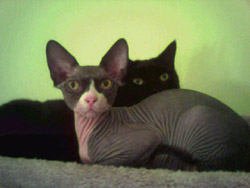 About Sphynx Cats
About Sphynx Cats
History of Sphynx

The Sphynx cat breed began in 1966, when a black and white cat gave birth to a hairless kitten in Ontario, Canada. The owner named the hairless kitten Prune, due to the wrinkled hairless skin. Prune was bred to other cats in attempt to create more hairless kittens. Because hairlessness is a recessive gene, some of the kittens resulting from this union had hair, while others did not. These kittens were called Canadian Hairless Cats, which some people referred to as Sphynx cats, due to their physical similarities with an ancient Egyptian cat sculpture called the Sphinx. However, the breed did not continue because these cats had serious health problems. It seemed that the cats' immune systems did not develop properly. As a result, the breeding ceased, and no efforts were made to continue the breed. Then, in 1975 in Wadena, Minnesota, a cat gave birth to several hairless kittens. One of the kittens was named Epidermis, who was bred to other cats in attempt to create the Sphynx breed. Three years later, several hairless kittens were found on the streets of Toronto, Canada. There was one male and two females. The male was named Bambi, and the females were named Punkie and Paloma. The two females were sent to the Netherlands to a Doctor Hernandez, a cat breeder interested in producing hairless cats. The females were bred to a Devon Rex, another cat with very little body hair. The resulting offspring of the European Sphynx cats are where the Sphynx breed began. Eventually, The International Cat Association (TICA) recognized the Sphynx as a breed, and the cats were permitted to be exhibited at the TICA shows. In 1998, Cat Fanciers' Association recognized them as a breed. There are now several thousand Sphynx registered in the world.
About Sphynx
Sphynx cats are cuddly, friendly, and intelligent creatures. Sphynx make excellent companions. They love being around people, and cuddling and purring. Try mopping a floor with a Sphynx, or making up a bed with Sphynx in it! They love being the center of attention, and will do nearly anything to get their owners to cuddle them. Sphynx come in a variety of colors, such as white, red, black, brown, calico, tortoiseshell, among others. Just because the Sphynx is a hairless breed, does not mean they are totally hairless. Many Sphynx have little baby hairs on their backs called "down", and may sprout hair behind their ears, on their tails, and on their feet, while some Sphynx are totally bald or "sticky bald". Some cats sprout extra fuzz on their bodies during the Winter, and lose it during the Spring. Since Sphynx cats are virtually hairless, they tend to go where the heat is: on computer monitors, printers, televisions, under covers, etc. Touching the skin of a Sphynx is similar to that of touching warm suede, or a warm peach. Those who have Sphynx recognize them as warm cuddly creatures with childlike personalities. They are incredibly loyal and love their humans.
Below is a copy of the TICA Sphynx breed standard, along with the number of points awarded for each feature on a Sphynx during a cat show.
TICA Sphynx Standard
^Top of Page